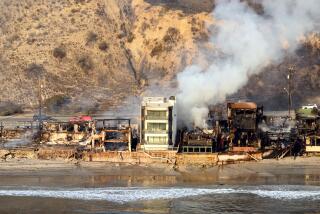EARTHQUAKE: THE LONG ROAD BACK : Damage Not as Serious as First Believed : Simi Valley: ‘Unsafe’ signs are posted at 100 structures, but officials say many others need only cosmetic repairs.
- Share via
As the pace of building inspections picked up in Simi Valley on Thursday, city officials said they were pleased to find that the homes and businesses checked so far were less severely damaged than previously believed.
Officials held to their previous estimate that the earthquake damaged 5,000 homes, or one-sixth of the city’s households. But as 45 workers fanned out in response to 2,000 calls for inspection, city officials said much of the damage was cosmetic, or at least posed no danger to residents.
“It’s just not as alarming” as many residents had reported to city officials when requesting the inspections, city building official Gaddis Farmer said.
Still, the building inspectors who traveled across the city Thursday posted red “Unsafe to Enter” signs on about 100 mobile homes, apartments and houses. Officials estimated that 250 to 300 homes around the city will be ruled unsafe to enter. So far, 622 mobile homes of about 800 to 900 in the city have been declared uninhabitable.
Inspectors also slapped the red signs on at least 17 churches and commercial and industrial buildings. One of the city’s two cinema complexes--the Mann 6 on Cochran Street--was roped off and tacked with a sign saying “Danger, Uninhabitable.”
Most houses and mobile homes that are deemed unsafe to enter will be inhabitable once they are repaired, Farmer said. Even mobile homes that were knocked off their foundations or split in two can be lifted up or put back together, he said.
In neighborhoods other than mobile home parks, two of the most common problems inspectors noted were fireplaces that had fallen or shifted out of place, and outside staircases at apartment buildings that are unusable.
Although such problems need immediate attention, most of the time they can be repaired, Farmer said.
The only problem for residents may be paying for the repairs.
One of the hundreds of Simi Valley residents who came to the local federal disaster assistance office Thursday said he has no hope of salvaging his home without federal aid.
John Holley said the earthquake knocked down walls in his 27-year-old house, causing damage that he estimated at $50,000.
Although he has earthquake insurance that will cover most of the cost, Holley has to pay the first $5,000. And Holley, 62, a laid-off aerospace worker, said he doesn’t have that kind of money.
“I’m drawing Social Security, which is nothing at 62,” he said.
In addition to damaging homes and businesses, the earthquake took its toll on the city’s cultural heritage.
A nearly 200-year-old adobe house that is the oldest dwelling in Ventura County sustained so much structural damage that it will be closed to the public indefinitely, Simi Valley City Historian Pat Havens said Thursday.
Located in Robert P. Strathearn Historical Park off Madera Road, the adobe had been proposed for seismic retrofitting to reinforce its 3-foot-thick walls against earthquakes. But the local park district that owns the building had not been able to raise the $250,000 needed for the work.
Now the park district will have to keep the adobe closed to school groups and other visitors until it finds the money to repair the building and bring it into compliance with state earthquake safety codes, Havens said.
Although Simi Valley residents may be more upset about the damage to their houses, Havens said closing the adobe represents a real loss to the city.
“It means a great deal,” she said. “If we don’t have our roots with the past, it’s hard for us to know how we got where we are.”
Simi Valley residents won’t have to worry about the fate of their local library, courthouse or other public buildings. City inspectors said Wednesday that all public, city-owned buildings had been spared structural damage.
In addition to surveying damage, a key role of building inspectors following a disaster is to put the public at ease, Farmer said.
Indeed, some residents said they felt more relaxed and calm Thursday than at any time since the temblor, mostly because of the lack of severe aftershocks during the day.
Many residents took advantage of the calm to climb on their roofs to repair chimneys and cover holes with plastic.
“I do feel better,” said Julie Mason, who spent Thursday cleaning house as her husband and a relative fixed her home’s chimney. “But if we get another big aftershock, I know I’m going to be back where I was.”
More to Read
Sign up for Essential California
The most important California stories and recommendations in your inbox every morning.
You may occasionally receive promotional content from the Los Angeles Times.













